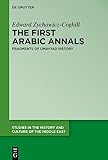The First Arabic Annals : Fragments of Umayyad History / Edward Zychowicz-Coghill.
Material type: TextSeries: Studies in the History and Culture of the Middle East ; 41Publisher: Berlin ; Boston : De Gruyter, [2021]Copyright date: ©2021Description: 1 online resource (VIII, 127 p.)Content type:
TextSeries: Studies in the History and Culture of the Middle East ; 41Publisher: Berlin ; Boston : De Gruyter, [2021]Copyright date: ©2021Description: 1 online resource (VIII, 127 p.)Content type: - 9783110712650
- 9783110712940
- 9783110712896
- online - DeGruyter
- Issued also in print.
| Item type | Current library | Call number | URL | Status | Notes | Barcode | |
|---|---|---|---|---|---|---|---|
 eBook
eBook
|
Biblioteca "Angelicum" Pont. Univ. S.Tommaso d'Aquino Nuvola online | online - DeGruyter (Browse shelf(Opens below)) | Online access | Not for loan (Accesso limitato) | Accesso per gli utenti autorizzati / Access for authorized users | (dgr)9783110712896 |
Frontmatter -- Acknowledgements -- Contents -- Introduction: An Arabic History from 8th-Century Egypt -- 1 Using isnāds to Identify Quotations of Books -- 2 Repeated riwāya-isnāds to al-Layth’s –Taʾrīkh Presenting Common Information -- 3 Five Independent Witnesses to Ibn Bukayr’s Recension of al-Layth’s -Taʾrīkh -- 4 Al-Layth’s –Taʾrīkh or Ibn Bukayr’s? -- 5 The Scope and Content of al-Layth’s –Taʾrīkh -- 6 Al-Layth and Ibn Bukayr -- Conclusions -- Edition and Translation -- Bibliography -- Index of Names and Places
restricted access online access with authorization star
http://purl.org/coar/access_right/c_16ec
The earliest development of Arabic historical writing remains shrouded in uncertainty until the 9th century CE, when our first extant texts were composed. This book demonstrates a new method, termed riwāya-cum-matn, which allows us to identify citation-markers that securely indicate the "ation of earlier Arabic historical works, proto-books first circulated in the eighth century. As a case study it reconstructs, with an edition and translation, around half of an annalistic history written by al-Layth b. Saʿd in the 740s. In doing so it shows that annalistic history-writing, comparable to contemporary Syriac or Greek models, was a part of the first development of Arabic historiography in the Marwanid period, providing a chronological framework for more ambitious later Abbasid history-writing. Reconstructing the original production-contexts and larger narrative frames of now-atomised "ations not only lets us judge their likely accuracy, but to consider the political and social relations underpinning the first production of authoritative historical knowledge in Islam. It also enables us to assess how Abbasid compilers combined and augmented the base texts from which they constructed their histories.
Issued also in print.
Mode of access: Internet via World Wide Web.
In English.
Description based on online resource; title from PDF title page (publisher's Web site, viewed 28. Feb 2023)


